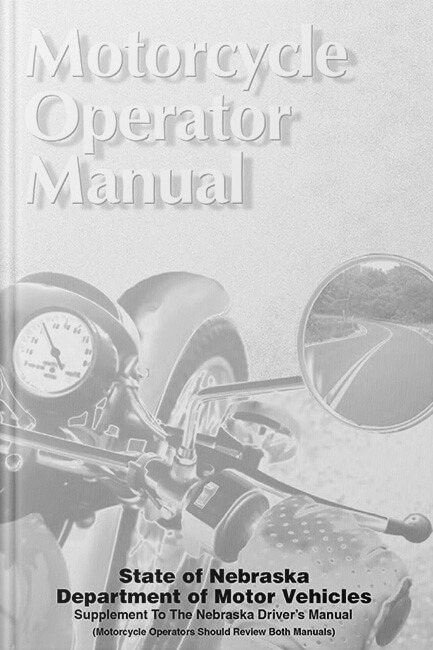
Nebraska Motorcycle Manual
The State of Nebraska’s Department of Motor Vehicles is dedicated to helping applicants prepare for the motorcycle exam, but more importantly, it’s concerned that there are safe, responsible riders on the road.
Nebraska’s DMV has released a Nebraska Motorcycle Operator’s Manual, which is designed as a supplement to the Nebraska Driver’s Manual. It’s recommended that prospective motorcyclists carefully review both manuals.
Nebraska Motorcycle Laws
In Nebraska, a motorcycle is defined as any motor vehicle that has a seat or saddle for the driver that is designed to travel on no more than three wheels. Other motorcycle-specific laws include:
- Motorcycle and moped operators and passengers must wear DOT-certified helmets. Those who do not comply with the helmet law will be fined $50.
- Motorcyclists are not permitted to overtake and pass in the same lane occupied by the vehicle being overtaken.
- Motorcyclists are not permitted to operate their vehicles between lanes of traffic or between adjacent lines/rows of vehicles.
- No motorcyclist should attach him/herself to the motorcycle or any other vehicle on a roadway.
- Motorcycles carrying a passenger, other than in a side car/enclosed cab shall be equipped with footrests for the passenger.
- Motorcycles must not have handlebars that are more than fifteen inches above the mounting point of the handlebars.
Getting the Motorcycle License
The licensing process in Nebraska is not unlike other states. It involves both a written knowledge test and a practical skills test. The knowledge test is based on information, techniques and practices that are in the Nebraska Motorcycle Operator’s Manual. The objective of the test is to ensure that you are familiar with the road rules and understand safe riding practices.
Careful review of the NE Manual will ensure your success on the knowledge test. The Manual involves the following components:
- Preparing to ride
- Riding within your abilities
- Being in shape to ride
- Earning your license
- Information for three-wheeled vehicles
Are you ready?
After close study of the Nebraska Motorcycle Operator’s Manual, you should be able to answer the following practice questions:
- What should a good rider do to reduce his/her reaction time?
- What is the purpose of making eye contact with other drivers on the road?
- When should a rider use the horn?
- What is the best way to stop a motorcycle quickly?
- What is the best thing to do should it start raining?
- What should a rider do if he/she is being chased by a dog?
The answers to these questions and more are contained in your NE Motorcycle Manual. What are you waiting for? Start reading the manual!